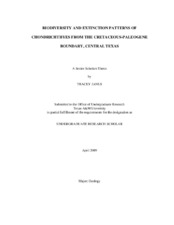| dc.description.abstract | The Cretaceous-Paleogene (KP) mass extinction is the second largest mass extinction in
the history of the world with over 70% of known marine and terrestrial species suffering
extinction in that event. One of the most well studied KP sections is located in the
Brazos River in Falls/Milam County and has been extensively studied for its
sedimentology, isotopic properties, and latest Cretaceous microfossils, but the vertebrate
fauna has not been studied until now. The Brazos River sites are composed of
hummocky cross-bedded sandstone beds with intercalated bone beds between the
hummocks.
I sorted hundreds of teeth from sharks, batoids, and bony fish, as well as thousands of
bone fragments from the processed sediments. At present, I have identified at least 15
genera and 18 species of elasmobranchs including members of the genera Rhinobatos,
Rhombodus, Squalicorax, Carcharias, and Pararhincodon. The chondrichthyian fauna
iv
from the Brazos sites inhabited many different niches ranging from benthic to pelagic
forms. Modern members of many of the chondrichthyian forms inhabit shallow, warm to
temperate waters, with some forms that are found in deeper waters. Of the identified
genera 73% are found after the KP Boundary, but none of the identified species are
known to occur in the Paleogene. The Brazos River sites show a high degree of
chondrichthyian biodiversity right before the KP Boundary. The Brazos River sites were
compared to four other late Maastrichtian North American sites using Simpson’s Faunal
Similarity index. The Kemp Clay in Texas shared 86.67% of its genera with the Brazos
sites; the Arkadelphia Formation in Arkansas shared 66.67% of its genera with the
Brazos sites; the Peedee Formation in North Carolina shared 37.5% of its genera with
the Brazos sites; and the New Egypt Formation in New Jersey shared 46.67% of its
genera with the Brazos sites. As expected, geographically closer regions had a higher
faunal similarity index than regions separated by greater distances. | en |


